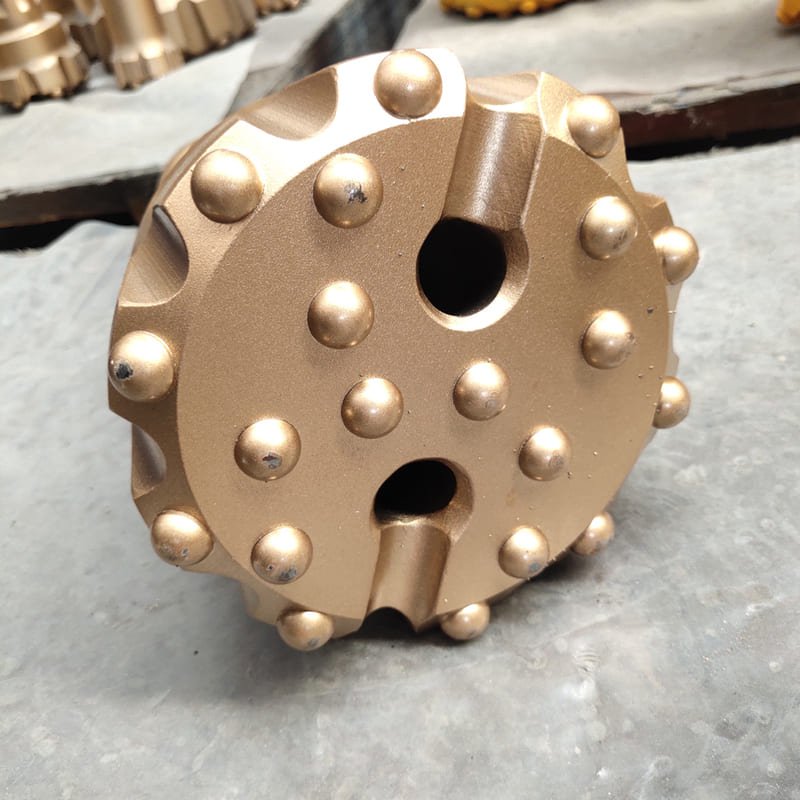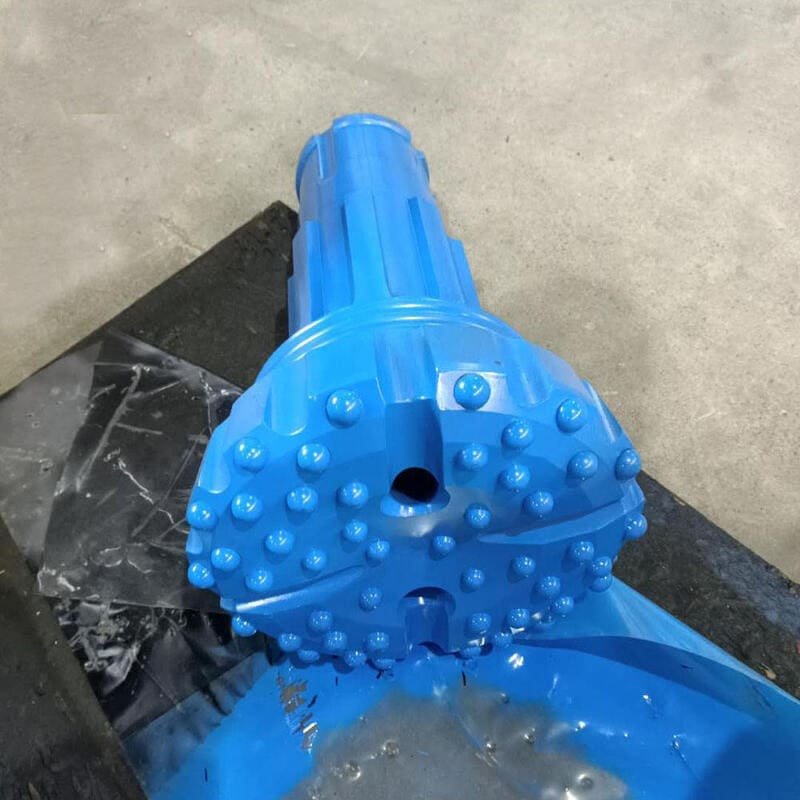Maintaining my DTH drill bits in excellent condition is essential for my work. Regular upkeep helps me avoid sudden equipment failures. Routine checks also prevent expensive interruptions. This habit really pays off.
Regular inspections of DTH drill bits maintain their effectiveness. Examine them every 175 to 200 hours for standard dry drilling. Check them more often in tough conditions, around every 100 hours. Really important! Daily, carry out visual checks. Clean them thoroughly after each use. These steps are very essential for their best performance.
When I first began using DTH drill bits, I did not realize how important regular checks were. Annoying incidents opened my eyes. Inspections every 175 to 200 hours are crucial for standard dry drilling. In tougher conditions, checking every 100 hours is necessary. Now, I do daily visual inspections and clean the bits thoroughly after use. These habits improve performance and increase equipment lifespan. My tools are always ready for the next task. I started recording all maintenance activities. This helps me monitor wear and avoid unexpected problems.
DTH drill bits should be inspected every 175 to 200 hours.True
Regular inspections help ensure DTH drill bits maintain optimal performance and longevity.
Daily visual checks are unnecessary for DTH drill bits.False
Daily visual checks are essential to catch potential issues early and ensure efficiency.
How Can I Identify Signs of Wear in DTH Drill Bits?
Noticing wear in DTH drill bits is crucial for keeping drilling operations efficient and safe. I want to share what I learned about spotting these signs. It's important to catch them early before they cause expensive problems.
To find signs of wear in DTH drill bits, search for chipping or cracks. Check for increased time to drill through materials. Listen for unusual vibrations or noise. Notice changes in the quality of drilling fluid. Identify misalignment during visual inspections.

Understanding DTH Drill Bit Wear
DTH drill bits, essential in deep drilling operations, face significant wear and tear due to harsh drilling conditions. Regular inspections are critical to ensure that the bits maintain their performance. Here are key signs of wear to look for:
-
Physical Damage
- Chipping and Cracking: Last month, I saw a bit with visible chipping. It had been pushed too hard through tough rock. This was a wake-up call. These bits can only handle so much stress.
- Wear on Buttons: The buttons on the bit should be sharp and efficient. They lose their edge over time. When this happens, drilling efficiency drops greatly.
-
Performance Degradation
- Increased Penetration Time: On one project, our penetration times started to increase. I discovered it was due to worn bits. Keeping track of these times is very important.
- Vibration and Noise: Excessive vibration or noise during operation feels unsettling. It often clearly shows the bit is not working properly.
-
Drilling Fluid Changes
- Mud Return Quality: Changes in the quality of drilling mud return often indicate a problem with the bit.
- Color and Composition of Mud: If the mud color changes or has more debris than usual, investigate further.
-
Visual Inspection Techniques
- Conduct visual checks regularly, especially after the first day of operation. Look for:
- Misalignment of the bit
- Accumulation of debris on the bit’s surface
- Conduct visual checks regularly, especially after the first day of operation. Look for:
For detailed insights on maintenance practices, check this maintenance guide1.
Tips for Early Detection
Implementing a systematic approach for inspection can help catch wear signs early:
- Daily Visual Inspections: A quick look reveals early wear signs.
- Performance Tracking: Keep records of penetration rates and operational conditions to spot trends.
- Use of Wear Indicators: Some modern DTH bits come with built-in indicators to signal when they are reaching their limit. For more information, explore advanced technologies2.
Maintenance Best Practices
| Maintaining your DTH drill bits can extend their lifespan: | Practice | Description |
|---|---|---|
| Regular Cleaning | Remove dirt and debris after each use to prevent buildup. | |
| Lubrication Checks | Ensure proper lubrication to reduce friction and wear on moving parts. | |
| Rotation of Bits | Rotate bits during operation to promote even wear across the bit's surface. | |
| Log Maintenance Activities | Maintain a log to track performance and identify wear patterns over time. |
These practices not only help in prolonging the life of your drill bits but also enhance overall operational efficiency. For further strategies, refer to this operational efficiency article3.
Chipping on DTH drill bits indicates excessive wear.True
Visible chipping on drill bits signifies undue stress, which can reduce drilling efficiency and performance.
Daily inspections are unnecessary for DTH drill bits.False
Regular visual inspections are essential to detect early signs of wear and maintain optimal performance of DTH drill bits.
How Do Environmental Conditions Influence Maintenance Frequency?
Do you ever think about how the surroundings affect your equipment's care? I realized that knowing this link is important. It very much helps increase performance and make tools last longer. Equipment lasts longer when used wisely.
Environmental conditions greatly affect how often equipment needs maintenance. Temperature, humidity and pollutants determine the frequency of checks and repairs. Regular inspections help keep equipment running smoothly. Conditions impact performance a lot.

Impact of Environmental Factors on Equipment Wear
Environmental conditions affect how often maintenance needs to happen. They are more than just background noise. For example, temperature changes have a big effect. During a hot project, our lubricants broke down faster. So, we needed to check them more often.
Temperature is a critical factor. When it goes above 100°F, I inspected every 50 hours. In cooler weather, checks happened every 200 hours. Temperature really changes everything.
| Temperature Range | Maintenance Frequency |
|---|---|
| Above 100°F | Every 50 hours |
| 60°F - 100°F | Every 100 hours |
| Below 60°F | Every 200 hours |
Humidity and Its Effects
Humidity is important, too. High humidity causes rust and corrosion, especially on metal. Low humidity leads to static electricity problems. Sensitive electronics suffer a lot because of it. To tackle this, I did regular inspections.
With high humidity, I scheduled maintenance every 75 hours, compared to 150 hours in drier areas. Dehumidifiers were very useful; they helped reduce moisture problems and maintenance.
Pollutants and Contaminants
Polluted environments need more frequent cleaning and lubrication. Dusty areas demand regular clean-ups to keep things working well. This is crucial in drilling operations since debris badly affects performance.
| Pollution Level | Recommended Maintenance Interval |
|---|---|
| High | Every 50 hours |
| Moderate | Every 100 hours |
| Low | Every 200 hours |
Regular cleaning is necessary to address this concern.
Adjusting Maintenance Schedules
I often monitor environmental conditions; it is one of the best strategies. Sensors tracking temperature, humidity, and contamination levels changed everything. The data helps me adjust how often we perform maintenance dynamically.
Explore more on adaptive maintenance strategies4 to understand how to implement these practices effectively.
By adjusting maintenance to fit environmental conditions, I've seen how companies perform better. This approach cuts down on downtime and improves operational efficiency over time.
Conclusion
The link between environmental factors and maintenance frequency is complex. I’ve learned to understand it deeply through years in this field. By knowing how these factors interact, I developed a better maintenance strategy for my equipment's longevity.
For further insights on optimizing maintenance based on environmental factors, consider exploring additional resources here5. My journey taught me that focusing on these factors makes a big difference.
High temperatures increase maintenance frequency for equipment.True
Equipment in high-temperature environments requires more frequent inspections due to accelerated wear, particularly on lubricants and seals.
Low humidity leads to more frequent maintenance checks.False
Contrary to high humidity, low humidity can cause static build-up, necessitating regular inspections to protect sensitive electronics.
How Can I Make My Drill Bits Last Longer?
Have you ever felt frustration with a dull drill bit just when needed most? I have experienced that too! Learning proper cleaning methods helps me save money. These methods also keep my projects running smoothly. I will explain how I keep my drill bits in great condition!
Keep your drill bits lasting longer by cleaning them regularly. Apply proper lubrication to prevent wear. Inspect them daily for any damage. Store them in a safe and dry place. Rotate their use for even wear. These simple steps protect the quality and performance of your drill bits. Quality matters!

Regular Cleaning Routine
Caring for my drill bits has become a routine I really enjoy after each project. It's like caring for my own belongings. I learned that cleaning in simple ways helps my drill bits last longer. Now, I want to share what works for me.
After using them, I clean my drill bits thoroughly. It might feel a bit repetitive, but it truly works wonders. I gently remove dirt, debris or any drilling mud that sticks. This stops corrosion and keeps the bits sharp for the next task.
For deep cleaning, I use:
- Compressed Air: A quick burst of air works wonders in removing sticky debris.
- Soft Brushes: These brushes work like gentle cleaners. They easily remove leftover residue without scratching the surface.
Learn more about effective cleaning tools6.
Lubrication Practices
Learning about lubrication changed everything for me. I now use the right lubricant for my drilling conditions naturally. This lubrication reduces friction, leading to smoother tasks and cooler bits.
| Lubricant Type | Best For | Application Frequency |
|---|---|---|
| Water-based | Wet drilling conditions | Every 100 hours of use |
| Oil-based | Standard dry drilling | Every 175-200 hours of operation |
| Grease | Heavy-duty applications | Monthly inspections |
Explore the right lubricants for your needs7.
Visual Inspections
Regular visual inspections really matter! They help me find any damage or wear before they worsen. Before each project, I check my drill bits for:
- Cracks or chips
- Overheating signs, like discoloration
- Alignment problems
Using a checklist has really helped me. It ensures I don't miss anything important.
Get tips for effective inspection methods8.
Proper Storage Techniques
Storing my bits well is very important after a long drilling day. I avoid keeping them in wet or harsh places because that leads to rust. So, I do the following:
- Store them in a dry case with cushioning to prevent damage.
- Label containers to quickly find the needed bit.
- Add silica gel packs to absorb extra moisture.
Discover the best storage solutions.
Rotation and Usage Practices
I found that rotating my drill bits while using them helps wear them evenly. It's very useful in projects with different rock hardness levels. I created a rotation schedule considering:
- The material type being drilled
- How long I drill without stopping
These steps have saved me money on replacements and made my drilling tasks really efficient.
Learn about optimal usage practices9.
Regular cleaning extends drill bit lifespan.True
Implementing a consistent cleaning routine prevents corrosion and maintains sharpness, thereby significantly extending the longevity of drill bits.
Visual inspections are unnecessary for drill bits.False
Conducting regular visual inspections is essential to identify wear or damage early, preventing costly repairs and maintaining performance.
Why Is Documentation Important in Maintenance Practices?
Have you ever thought about how much documentation affects our daily work? Documentation plays an essential role, just like an unsung hero. Everything works smoothly because of it. We focus on the bigger tasks.
Documentation is very important in maintenance work. It improves efficiency, tracks work results and follows safety rules. Correct records identify trends. Records also support proactive maintenance plans.

Enhancing Maintenance Efficiency
Documentation supports efficient maintenance work. It’s like having a clear map when exploring unknown places. Accurate records of maintenance activities show trends and patterns in equipment performance. For example, I learned that tracking how often our DTH drill bits received service under various conditions helped us decide when to schedule future maintenance. This smart approach reduced unexpected failures and probably saved us both time and money.
Additionally, leveraging technology such as digital maintenance management systems10 helps us organize documentation processes, making it easier to update and access information.
Tracking Equipment Performance
Regular documentation tracks equipment performance over time. In my early days, I worked on a project where maintenance activities were recorded precisely. Analyzing that data showed the average lifespan of different parts and helped us predict replacements accurately.
| Equipment Type | Average Lifespan | Recommended Inspection Frequency |
|---|---|---|
| DTH Drill Bits | 300-500 hours | Every 100 hours in challenging conditions |
| Drilling Hammers | 500-700 hours | Monthly or after heavy usage |
This careful method kept our equipment working at its best. It really improved our operational efficiency.
Compliance with Safety Regulations
In my career, I learned that proper records are not only about efficiency but also safety. Many industries have strict safety standards that require thorough documentation of maintenance procedures and safety checks. Once, during a stressful audit, our detailed daily inspection records helped us show we followed safety rules.
Best Practices for Documenting Maintenance Activities
To get the most out of documentation in maintenance, I follow some best practices:
- Create Standardized Forms: Templates for inspections and repairs ensure consistency and save time.
- Regularly Update Records: Real-time updates on all maintenance activities prevent information gaps.
- Train Staff: Everyone understanding the value of documentation really transformed our operations.
- Utilize Digital Tools: Using maintenance management software11 improved our record-keeping, making it accessible and efficient.
By following these best practices, I saw a culture of accountability and transparency grow in our maintenance operations. The transformation was remarkable. It all began with recognizing the importance of documentation.
Documentation improves maintenance efficiency in organizations.True
Accurate records help identify trends and enhance decision-making for future maintenance needs, leading to increased efficiency.
Regular documentation ensures compliance with safety regulations.True
Maintaining thorough records of maintenance procedures is essential for meeting industry safety standards and avoiding legal issues.
Conclusion
DTH drill bits require regular inspections every 175-200 hours, with daily visual checks and cleaning to ensure optimal performance and longevity in various drilling conditions.
-
Discover comprehensive insights on inspecting DTH drill bits effectively, ensuring longevity and performance. ↩
-
Learn about modern technologies that help in identifying wear signs in drilling equipment efficiently. ↩
-
Explore best practices for maintaining DTH drill bits to extend their operational life. ↩
-
Discover insights on how environmental factors impact equipment maintenance schedules, helping you optimize operations. ↩
-
Learn about the role of pollutants in determining maintenance needs for various machinery. ↩
-
Explore detailed cleaning techniques that can significantly extend the lifespan of your drill bits and improve their performance. ↩
-
Find out how lubrication affects drill bit longevity and which products are best suited for your needs. ↩
-
Get insights on how proper storage can prevent wear and damage to your drill bits over time. ↩
-
Learn about usage practices that can help you maintain your drill bits in optimal condition during various drilling applications. ↩
-
Discover comprehensive insights on the significance of documentation in maintenance to enhance your operational efficiency. ↩
-
Explore best practices for documenting maintenance activities effectively to improve your team's performance. ↩








